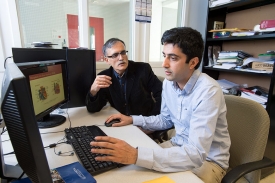Applying Engineering Science to the Human Body

C. Nataraj, PhD, with postdoctoral associate Ali Jalali, ’15 PhD
“Five hundred people will die in the United States today because of a medical misdiagnosis,” says Villanova's C. “Nat” Nataraj, PhD, the Mr. & Mrs. Robert F. Moritz, Sr., Endowed Chair in Engineered Systems. “The human body is a complex, nonlinear dynamic system that cannot be fully understood by conventional medical diagnostics. We, as engineers, can use physics, mathematics and computer algorithms to effectively and intelligently make diagnostics a whole lot better.”
A leader in the field of dynamic systems and nonlinear dynamics, Dr. Nataraj is the director of the College of Engineering's Center for the Analytics of Dynamic Systems, where Villanova experts in engineering, mathematics, computer science and business use data to analyze, diagnose and improve complex systems.
Dr. Nataraj explains that a great deal of data is collected when doctors examine patients and take tests. Using their knowledge and experience, along with the guidelines established by their field, they then try to fit the pattern into a disease model. If it fits well enough, a diagnosis is pronounced.
“This traditional method of medical diagnostics is problematic because of what we engineers call ‘pattern recognition,’” says Dr. Nataraj. He notes that diagnosing patients is challenging for several reasons, but mostly because the human body is a very complex system. Because every individual is different, the same set of parameters or conditions that may affect one person may not affect another. “In many instances it is very difficult to define what’s normal for a patient and what’s not,” he says.
“Engineers have relevant experience. They love data, and medical diagnostics is all about interpreting data to reach conclusions. In addition to looking at data, engineers know how to apply science, and they can apply the same science to human beings,” explains Dr. Nataraj.
For several years, Dr. Nataraj and postdoctoral associate Ali Jalali, ’15 PhD, have worked with a team at Children’s Hospital of Philadelphia to tackle Periventricular Leukomalacia, a common brain injury that affects babies who have cardiac issues. PVL can cause serious speech, cognition and motor skills problems, which if left untreated, can be fatal. The research is funded by a $1.9 million grant from the National Institutes of Health.
Drs. Nataraj's and Jalali's research involves tracking data from blood pressure, heart rate and gas concentration readings, as well as MRI images, to develop algorithms to predict not only when PVL may occur, but also the severity of PVL cases so that medical staff can take preventive measures or apply effective treatments. For the first time in the history of the disease, the team has a 90 percent accuracy rate for predicting PVL.
Dr. Nataraj also is in collaboration with physicians in CHOP’s intensive cardiac unit, which houses infants with the most life-threatening conditions, to apply a similar approach to help the staff pinpoint which children’s conditions may worsen overnight, based on daily data analysis.
A third CHOP project with Villanova colleague Garrett Clayton, PhD, associate professor of Mechanical Engineering, involves designing a better way to perform CPR. According to the Journal of the American Medical Association (2013), the success rate of CPR given by healthcare professionals is only 30 percent in the case of a young, healthy person. “Our goal is to determine the optimum way to perform CPR to make it more effective,” says Dr. Nataraj. “With nearly 300,000 cardiac arrests in U.S. hospitals every year (American Heart Association, 2013), we hope our research will lead to a product that will save lives.”
Finally, Dr. Nataraj is working with anesthesiologists at CHOP to design a procedure to increase the effectiveness of intubation in the hospital setting. “We are looking closely at the causes for intubation failure, something that is often preventable,” he says.
---
On November 15, 2016, U.S. News & World Report featured Doctors Work with Engineers to Improve Diagnoses, an article about Dr. Nataraj and his research.
To learn more about Dr. Nataraj’s work in the field of medical diagnostics, visit his website at http://www.vudsl.org and view his TEDx video “How engineers can help save lives.”
